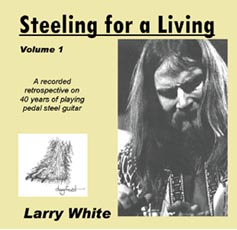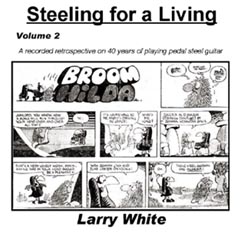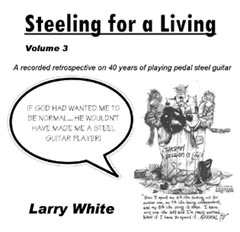Early Days | MSA Chapter | Panther Hall | LA Hayride | Saddle Tramps | CD
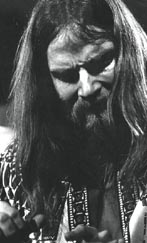 I
began playing music when in Jr. high school at about the age of 14. I was
attracted to the guys playing guitar in 50's rock and blues bands at school
dances. So I began to take guitar lessons. The first guitar teacher I went to
gave me a dobro and a bar. Why he chose to do that I don't know, but
none-the-less it proved to be the prophetic choice of instruments which I would
not discover for a couple of years to come. I returned the dobro at the next
lesson and said, "thanks but no thanks, teach me to play guitar". So began
the musical search that would eventually lead me back to where I could have
started had I just been obedient to the call. After a summer vacation of guitar
lessons, mom and dad and I returned to Dallas, TX from Lubbock, TX, not only our
vacation place, but also the place of my birth, Labor Day, September 02, 1946.
My mother always accepted with a smile that I was born on Labor Day and she did
all the work.
I
began playing music when in Jr. high school at about the age of 14. I was
attracted to the guys playing guitar in 50's rock and blues bands at school
dances. So I began to take guitar lessons. The first guitar teacher I went to
gave me a dobro and a bar. Why he chose to do that I don't know, but
none-the-less it proved to be the prophetic choice of instruments which I would
not discover for a couple of years to come. I returned the dobro at the next
lesson and said, "thanks but no thanks, teach me to play guitar". So began
the musical search that would eventually lead me back to where I could have
started had I just been obedient to the call. After a summer vacation of guitar
lessons, mom and dad and I returned to Dallas, TX from Lubbock, TX, not only our
vacation place, but also the place of my birth, Labor Day, September 02, 1946.
My mother always accepted with a smile that I was born on Labor Day and she did
all the work.
New guitar lessons began at Trick Brothers Music. What a name! Al Trick was an accordion teacher that had to take on guitar and Hawaiian guitar teachers and students as the post war popularity of the accordion waned. A gentleman named Jim Ashby began to give me guitar lessons. He played a Gretsch guitar, Chet Atkins style. So right away I got used to the idea that a thumb pick was a completely different entity than a flat pick and later that would become increasingly important to me as I gravitated to steel guitar. As I started to play guitar I was listening to Lawrence Welk's Neil LeVang and Buddy Merrill, two really great musicians, as well as Roy Lanham, who, for many years, played with The Sons of The Pioneers. Growing up, I had not listened to country music, even though I spent ages 5-12 in Louisville, KY, a hop skip and a jump from Nashville, TN. The next step in the transition was 5-string banjo. Well, Saturday afternoon TV in Dallas in the early 60's brought Porter Wagoner and The Wilburn Brothers to the air. I became fascinated with Buck Trent, Porter's electric 5 string banjo player and his incredibly innovative approach to 5-string banjo. Scruggs pegs, Kieth-Scruggs pegs, palm and elbow levers made by Sho-Bud, and a pickup under the strings, not the head, made him the most interesting player I had ever seen and I began to try emulate his style on 5-string. (I know now that Buck Trent was really a frustrated steel guitar player.) So, Part 2 of the steel guitar puzzle came together when I started using metal fingerpicks on banjo. (One interesting aside about my banjo playing, while on the road, years later, playing steel for Roy Drusky, I met Porter's first TV girl singer, Norma Jean, at a package show at Dinner Keys Coliseum in Miami, FL. She was traveling with her backup guitarist and I offered to play Buck Trent's electric 5-string parts on her records during her stage show. She paused, looked at her guitar player and then back at me and said, "No." I never felt the same about Norma Jean or 5-string banjo after that day.
Sometime
during this period I remember passing by a country radio station and heard
Marvin Rainwater's "Gonna' Find Me A Bluebird" and finally noticed the
"whiney" instrument on the recording and asked my guitar teacher what
that might be. Fortunately, he knew it was a steel guitar and promptly offered
to find one for me to try. The following week he came up with a single-neck
MultiChord 8-string with 5 cabled pedals, all at the left end of the guitar,
stair-stepped from back to front. The cables ran straight up to the tuning
block. Well, even with this as an introduction, I knew it felt right and was
something I wanted to do.
The first steel
guitar I ever owned, with the help of my dear father, was a Rickenbacker
8 string. That's right, a Rickenbacker! It was pretty advanced for the time:
each one of the 5 pedals would pull all 8 strings at once. Fortunately, at this
time, I met a steel guitar player here in Dallas named Tommy Bolinger, who began
to coach me about steel guitar tunings in use. I owe Tommy a debt of gratitude.
For without his help, I would have never understood the A6th tuning on the
Rickenbacker and why I didn't sound like the other pedal steel players around.
He also hipped me to the E9th tuning and explained the two-tuning double-neck
concept that many players had adopted, the perfect combination of C6th and E9th
tunings, "swing and corn". Tommy Bolinger owned a steel custom built by a
Dallas maker named Bill Dennison. Tommy had a double-neck that was all cast
aluminum and hand engraved everywhere. As luck would have it, Tommy worked for
Fred McCord Music, the original Fender dealer in Dallas since Fender's
inception in the late 40"s. So I began to look at Fender pedal steels and
wound up with a Fender 1000 double neck 8-string, 8 pedal, cable-driven steel. I
began to listen to Buck Owens, as did many, Ralph Mooney and Jaron "Jay"
McDonald and adopted a little bit of each into my playing.
After
school each day, I spent hours and hours behind a record player practicing with
some of the best country singers and bands around: Ray Price and the Cherokee
Cowboys, George Jones and the Jones Boys, Ray Price and the Cherokee Cowboys ,
Webb Pierce, Faron Young, Buck Owens and the Buckaroos, Ray Price and the
Cherokee Cowboys, Ernest Tubb and the Texas Troubadors, Ferlin Husky, Claude
Gray, Ray Price and the Cherokee Cowboys... well you get the idea. During this
time my guitar teacher and a girl singer, named Marsha Moore, and I began a real
garage band. In Texas during the summer we were a hot garage band! God bless
those two people and my parents as I learned to play. Even my dog howled when I
got above the 12th fret. Everybody's a critic. As I played with
this garage band, I learned about chord structure, bar noise, volume pedals,
filling behind a singer, playing in tune and the difference between the verse
and the bridge.
At
this point I'll say my obligatory thanks to my first and foremost record
player mentor, Buddy Emmons. Many of
us who play steel guitar owe this man a debt of gratitude... on that we all seem
to agree... and getting steel guitar players to agree isn't easy. Buddy's
musicality, depth of feel, musical expansiveness, and dedication to perfection
has been a positive influence on thousands of players and listeners alike. What
better beginnings could any of us have had?
Early Days | MSA Chapter | Panther Hall | LA Hayride | Saddle Tramps | CD
The MSA Chapter
No matter what kind of indirect influence Buddy Emmons may have had on my playing, I began to meet musicians that would have direct influences on my learning and playing when I ventured to a fledgling steel guitar company in Dallas. Newly started, MSA was building guitars in the back of a music store in Oak Cliff. Buddy Carter had just stopped by on his way from Missouri to California and asked if he could build himself a guitar. That was the true beginning of the business that would revolutionize the steel guitar building business. Maurice Anderson was the front man, salesman; Tom Morrell was the spirit of creativity; Buddy Carter was the mechanical genius and master builder. All three were experienced players and loved to play and absorb all kinds of music into their instruments. These guys set a great benchmark for Dallas-Ft. Worth players of all kinds. It was these guys who recommended me for the first really big gig I had played. Hired by a local bass player and singer, Ricky Beaver, I would open with them at The Golden Nugget in Las Vegas backing a Nashville singer-piano player named Norris (Norro) Wilson. On the way to Las Vegas in a 1950 Pontiac with a luggage rack and 6 passengers, Ricky Beaver casually asked what AFM Local I was a member of and I, of course said, "What union?" He freaked and when we got to Vegas we called Dallas and I joined the Dallas Local and am still a member to this day. We followed Rusty and Doug Kershaw into the 8PM to 12AM shift. I was 17 and couldn't even walk into the casino or the bar, but I was a union member. Opening night at 8PM, behind the curtain, my volume pedal foot was shaking and I couldn't control it. Five minutes after we started though, the shaking stopped and me and my Fender 1000 were excited about the music business and playing steel guitar. The learning had only begun. The below picture is of the same band back in Ft. Worth, TX at Panther Hall. That night we were backing Hank Locklin of "Please Help Me, I'm Falling" fame.
Early Days | MSA Chapter | Panther Hall | LA Hayride | Saddle Tramps | CD
The Panther Hall
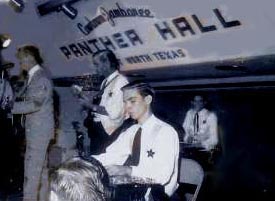 |
Ricky
Beaver, Bass Billy
Briggs, Fiddle Al
Breaux, Drums Buddy
Combs, Guitar
|
In the meantime, I bought a MSA steel guitar and began to listen to Maurice, Tom and Bud play. The summer after my first year at The University of Texas at Austin brought another playing opportunity from Bobby Bowman (at the time living in Dallas). He had been asked to play with Roy Drusky and decided he didn't want the gig. He passed the opportunity to me and I was off to Nashville. Gene Crawford was the bass player, front man, singer and John "Pokey" Foxworth was the drummer, rounding out the trio. That's right, a trio. Pokey was young enough that Gene had to sign on as his legal guardian just to get him into the nightclubs we were playing. Both were from Houston and we were all road ready.
Early Days | MSA Chapter | Panther Hall | LA Hayride | Saddle Tramps | CD
The Louisiana Hayride
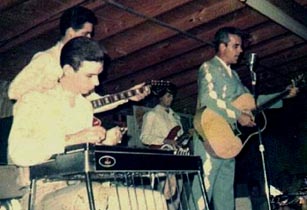 |
1967, Southern Louisiana Roy
Drusky, Vocals Gene
Crawford, Bass John
Foxworth, Drums Doyle
Grisham, Guitar |
We spent the summer playing all kinds of venues including appearances on Roy Drusky Grand Old Opry segments. When in town, I visited many sessions in Nashville studios. Saw and heard the first call players at work: Buddy Harmon, drums; Junior Husky, bass; Pig Robbins, piano; Ray Edenton, acoustic guitar; Grady Martin, guitar; Charlie McCoy, harmonica and about anything else. At the end of the summer I decided I would return to UT for the next semester and proceeded to find a replacement for the job. Somehow I was lucky enough to get Doyle Grisham to take the job. Doyle was fine guitar and steel guitar player then and still is. I believe he is still in Nashville.
Early Days | MSA Chapter | Panther Hall | LA Hayride | Saddle Tramps | CD
The Saddle Tramps
While in school at Austin, I drove back to Dallas most weekends to play with a local band called "Archie Shearer and the Saddle Tramps". And here we were:
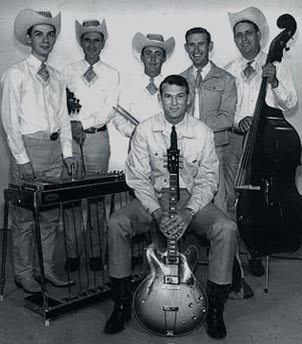 |
Archie
Shearer, Guitar, Vocals Larry
White, Steel Guitar Emory
Aaron, Fiddle Donnie
Young, Drums Charlie
Shearer, Guitar, Vocals
|
